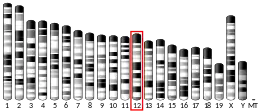GLRX5
Glutaredoxin 5, also known as GLRX5, is a protein which in humans is encoded by the GLRX5 gene located on chromosome 14.[5] This gene encodes a mitochondrial protein, which is evolutionarily conserved. It is involved in the biogenesis of iron- sulfur clusters, which are required for normal iron homeostasis. Mutations in this gene are associated with autosomal recessive pyridoxine-refractory sideroblastic anemia.[6]
| GLRX5 | |||||||||||||||||||||||||||||||||||||||||||||||||||
|---|---|---|---|---|---|---|---|---|---|---|---|---|---|---|---|---|---|---|---|---|---|---|---|---|---|---|---|---|---|---|---|---|---|---|---|---|---|---|---|---|---|---|---|---|---|---|---|---|---|---|---|
| |||||||||||||||||||||||||||||||||||||||||||||||||||
| Identifiers | |||||||||||||||||||||||||||||||||||||||||||||||||||
| Aliases | GLRX5, C14orf87, FLB4739, GRX5, PR01238, PRO1238, PRSA, SIDBA3, SPAHGC, glutaredoxin 5 | ||||||||||||||||||||||||||||||||||||||||||||||||||
| External IDs | OMIM: 609588 MGI: 1920296 HomoloGene: 31984 GeneCards: GLRX5 | ||||||||||||||||||||||||||||||||||||||||||||||||||
| |||||||||||||||||||||||||||||||||||||||||||||||||||
| |||||||||||||||||||||||||||||||||||||||||||||||||||
| |||||||||||||||||||||||||||||||||||||||||||||||||||
| |||||||||||||||||||||||||||||||||||||||||||||||||||
| |||||||||||||||||||||||||||||||||||||||||||||||||||
| Wikidata | |||||||||||||||||||||||||||||||||||||||||||||||||||
| |||||||||||||||||||||||||||||||||||||||||||||||||||
Structure
The GLRX5 gene contains 2 exons and encodes for a protein that is 13 kDa in size. The protein is highly expressed in erythroid cells.[7] Crystal structure of the GLRX5 protein reveals that the protein likely exists as a tetramer with two Fe-S clusters buried in the interior.[8]
Function
GLRX5 is a mitochondrial protein is conserved evolutionarily and plays a role in the formation of iron-sulfur clusters, which function to maintain iron homeostasis within the mitochondria and in the cell. GLRX5 is required for the steps in haem synthesis that involves mitochondrial enzymes,[9] and is therefore involved in hematopoiesis. GLRX5 activity is required for normal regulation of hemoglobin synthesis by the iron-sulfur protein ACO1. The function of GLRX5 is highly conserved evolutionarily.[10]
Clinical significance
Mutations in the GLRX5 gene have been associated with sideroblastic anemia,[11] variant glycine encephalopathy (also known as non-ketotic hyperglycinemia, NKH).[12] as well as pyridoxine-refractory, autosomal recessive anemia (PRARSA).[10] Cells with mutations in GLRX5 activity show deficiency in Fe-S cluster synthesis, which is likely causative of the observed symptoms.[7]
See also
References
- GRCh38: Ensembl release 89: ENSG00000182512 - Ensembl, May 2017
- GRCm38: Ensembl release 89: ENSMUSG00000021102 - Ensembl, May 2017
- "Human PubMed Reference:". National Center for Biotechnology Information, U.S. National Library of Medicine.
- "Mouse PubMed Reference:". National Center for Biotechnology Information, U.S. National Library of Medicine.
- Wingert RA, Galloway JL, Barut B, Foott H, Fraenkel P, Axe JL, Weber GJ, Dooley K, Davidson AJ, Schmid B, Schmidt B, Paw BH, Shaw GC, Kingsley P, Palis J, Schubert H, Chen O, Kaplan J, Zon LI (Aug 2005). "Deficiency of glutaredoxin 5 reveals Fe-S clusters are required for vertebrate haem synthesis". Nature. 436 (7053): 1035–39. Bibcode:2005Natur.436.1035W. doi:10.1038/nature03887. PMID 16110529. S2CID 4333813.
- "GLRX5 glutaredoxin 5 [Homo sapiens (human)] - Gene - NCBI". www.ncbi.nlm.nih.gov. Retrieved 2016-10-26.
- Ye H, Jeong SY, Ghosh MC, Kovtunovych G, Silvestri L, Ortillo D, Uchida N, Tisdale J, Camaschella C, Rouault TA (2010). "Glutaredoxin 5 deficiency causes sideroblastic anemia by specifically impairing heme biosynthesis and depleting cytosolic iron in human erythroblasts". J. Clin. Invest. 120 (5): 1749–61. doi:10.1172/JCI40372. PMC 2860907. PMID 20364084.
- Johansson C, Roos AK, Montano SJ, Sengupta R, Filippakopoulos P, Guo K, von Delft F, Holmgren A, Oppermann U, Kavanagh KL (2011). "The crystal structure of human GLRX5: iron-sulfur cluster co-ordination, tetrameric assembly and monomer activity". Biochem. J. 433 (2): 303–11. doi:10.1042/BJ20101286. hdl:10616/41576. PMID 21029046.
- Wingert RA, Galloway JL, Barut B, Foott H, Fraenkel P, Axe JL, Weber GJ, Dooley K, Davidson AJ, Schmid B, Schmidt B, Paw BH, Shaw GC, Kingsley P, Palis J, Schubert H, Chen O, Kaplan J, Zon LI (2005). "Deficiency of glutaredoxin 5 reveals Fe-S clusters are required for vertebrate haem synthesis". Nature. 436 (7053): 1035–39. Bibcode:2005Natur.436.1035W. doi:10.1038/nature03887. PMID 16110529. S2CID 4333813.
- Camaschella C, Campanella A, De Falco L, Boschetto L, Merlini R, Silvestri L, Levi S, Iolascon A (2007). "The human counterpart of zebrafish shiraz shows sideroblastic-like microcytic anemia and iron overload". Blood. 110 (4): 1353–8. doi:10.1182/blood-2007-02-072520. PMID 17485548.
- Camaschella C (Oct 2008). "Recent advances in the understanding of inherited sideroblastic anaemia". British Journal of Haematology. 143 (1): 27–38. doi:10.1111/j.1365-2141.2008.07290.x. PMID 18637800.
- Baker PR, Friederich MW, Swanson MA, Shaikh T, Bhattacharya K, Scharer GH, Aicher J, Creadon-Swindell G, Geiger E, MacLean KN, Lee WT, Deshpande C, Freckmann ML, Shih LY, Wasserstein M, Rasmussen MB, Lund AM, Procopis P, Cameron JM, Robinson BH, Brown GK, Brown RM, Compton AG, Dieckmann CL, Collard R, Coughlin CR, Spector E, Wempe MF, Van Hove JL (Feb 2014). "Variant non ketotic hyperglycinemia is caused by mutations in LIAS, BOLA3 and the novel gene GLRX5". Brain. 137 (Pt 2): 366–79. doi:10.1093/brain/awt328. PMC 3914472. PMID 24334290.
Further reading
- Davis DA, Newcomb FM, Starke DW, Ott DE, Mieyal JJ, Yarchoan R (Oct 1997). "Thioltransferase (glutaredoxin) is detected within HIV-1 and can regulate the activity of glutathionylated HIV-1 protease in vitro". The Journal of Biological Chemistry. 272 (41): 25935–40. doi:10.1074/jbc.272.41.25935. PMID 9325327.
- Camaschella C, Campanella A, De Falco L, Boschetto L, Merlini R, Silvestri L, Levi S, Iolascon A (Aug 2007). "The human counterpart of zebrafish shiraz shows sideroblastic-like microcytic anemia and iron overload". Blood. 110 (4): 1353–8. doi:10.1182/blood-2007-02-072520. PMID 17485548.
- Bergmann AK, Campagna DR, McLoughlin EM, Agarwal S, Fleming MD, Bottomley SS, Neufeld EJ (Feb 2010). "Systematic molecular genetic analysis of congenital sideroblastic anemia: evidence for genetic heterogeneity and identification of novel mutations". Pediatric Blood & Cancer. 54 (2): 273–8. doi:10.1002/pbc.22244. PMC 2843911. PMID 19731322.



